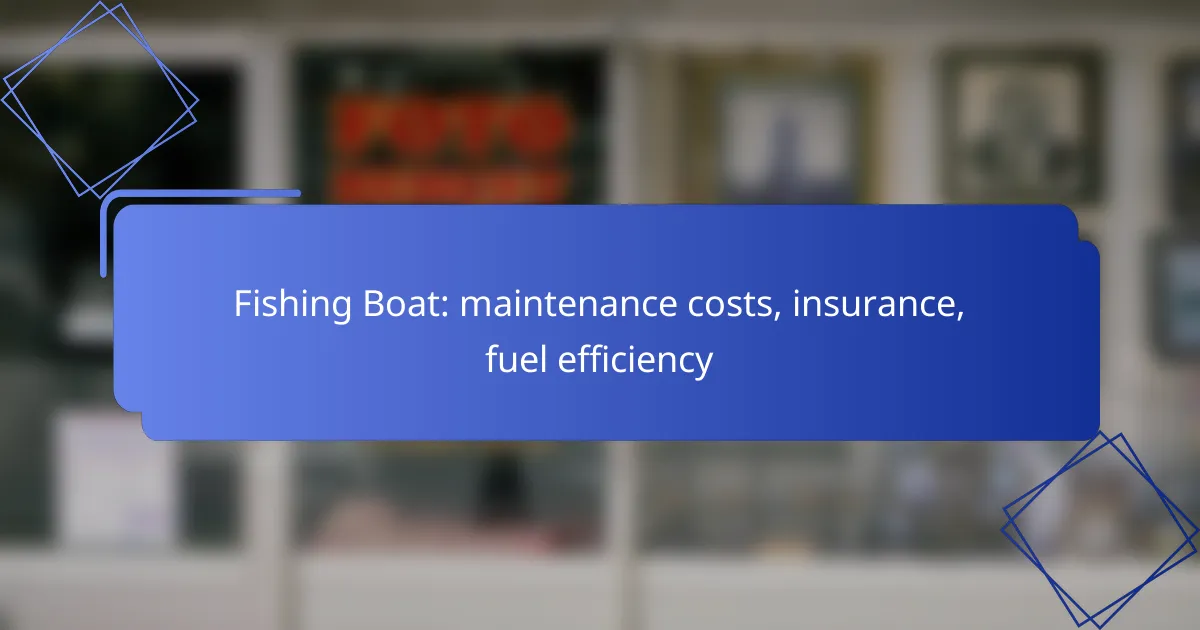Owning a fishing boat involves various costs, including maintenance, insurance, and fuel efficiency. Maintenance expenses can range from a few thousand pounds annually, influenced by the boat’s type, age, and usage. Additionally, selecting the right insurance policy is crucial, with options available to suit different needs, from basic liability to comprehensive coverage for commercial fishing operations.
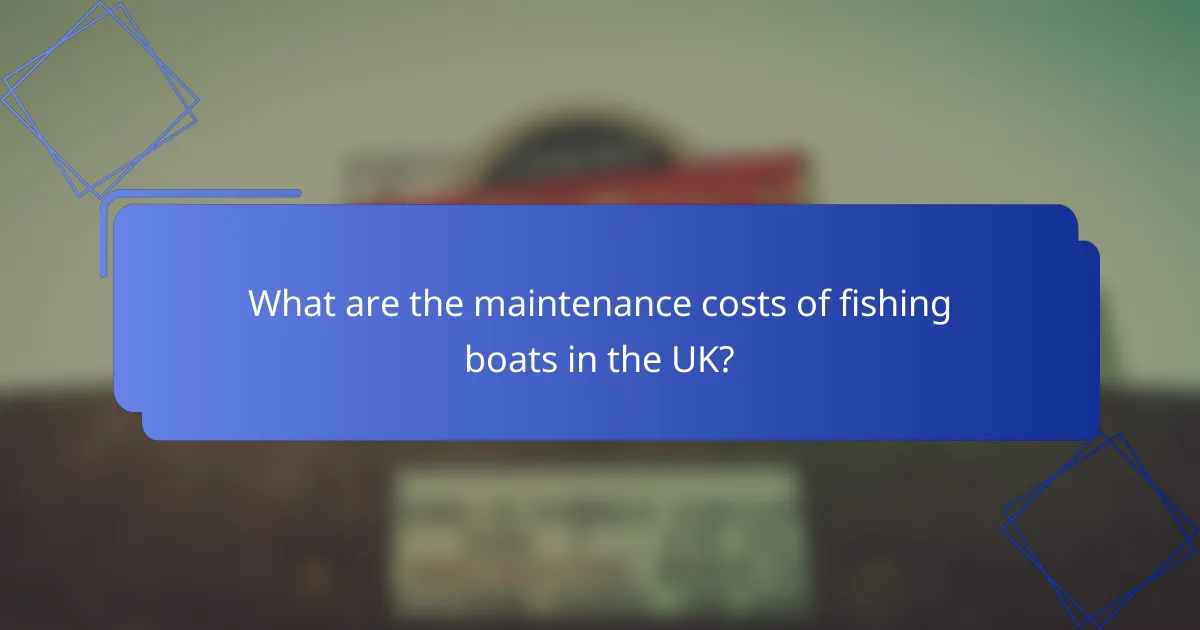
What are the maintenance costs of fishing boats in the UK?
The maintenance costs of fishing boats in the UK can vary significantly based on the type of boat, its age, and usage. On average, boat owners can expect to spend a few thousand pounds annually on upkeep, including repairs, servicing, and inspections.
Average annual maintenance costs
Annual maintenance costs for fishing boats in the UK typically range from £1,500 to £5,000. This includes routine services, repairs, and parts replacement. Larger vessels or those used more frequently may incur higher costs, sometimes exceeding £10,000 per year.
Factors affecting maintenance costs
Several factors influence the maintenance costs of fishing boats. The age of the boat plays a significant role; older boats often require more frequent repairs and parts replacement. Additionally, the type of fishing activity, whether commercial or recreational, can impact the level of maintenance needed.
Environmental conditions also affect costs. Boats operating in harsher marine environments may experience faster wear and tear, leading to increased maintenance expenses. Regular inspections and adherence to safety regulations can help mitigate some of these costs.
Cost comparison by boat type
Different types of fishing boats have varying maintenance costs. For instance, small recreational boats may have lower annual costs, often between £1,500 and £3,000. In contrast, commercial fishing vessels, which are larger and more complex, can see maintenance costs ranging from £5,000 to over £15,000 annually.
Here’s a simplified comparison of average maintenance costs by boat type:
| Boat Type | Average Annual Maintenance Cost |
|---|---|
| Small Recreational Boat | £1,500 – £3,000 |
| Medium Fishing Vessel | £3,000 – £7,000 |
| Large Commercial Vessel | £5,000 – £15,000+ |
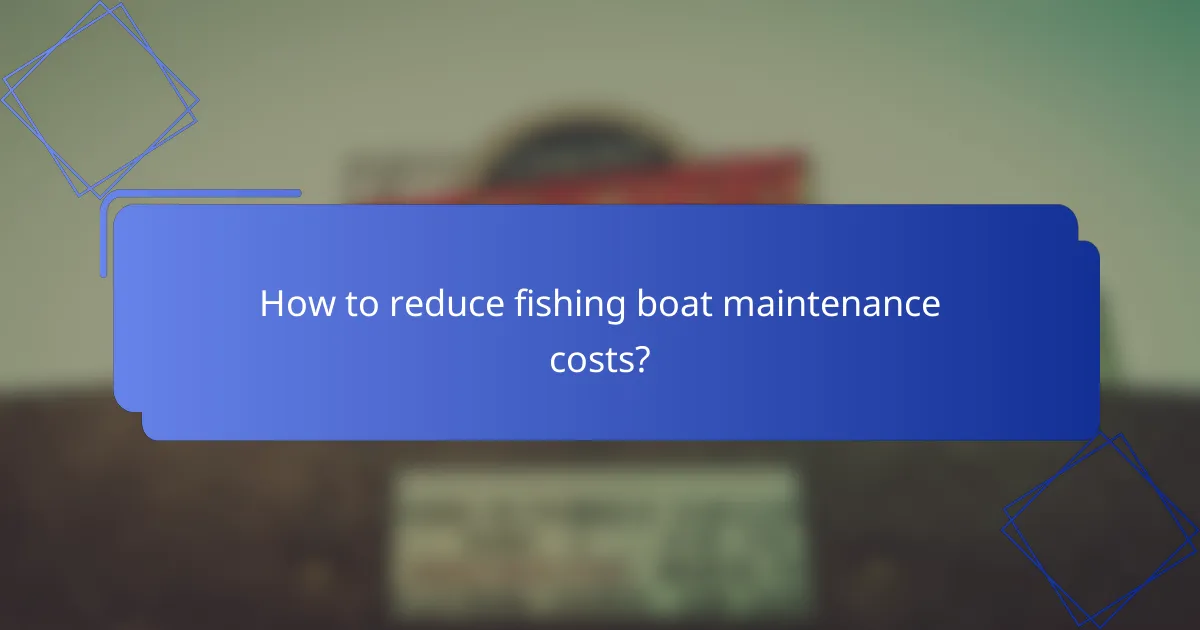
How to reduce fishing boat maintenance costs?
To reduce fishing boat maintenance costs, focus on regular upkeep, perform simple repairs yourself, and choose durable materials. Implementing these strategies can significantly lower expenses over time.
Regular maintenance schedules
Establishing a regular maintenance schedule is essential for keeping your fishing boat in good condition and minimizing costs. Routine checks can help identify issues early, preventing costly repairs later. Aim for inspections every few months, especially before and after the fishing season.
Key tasks to include in your schedule are checking the engine, inspecting the hull for damage, and ensuring all safety equipment is functional. Keeping a log of maintenance activities can help track what has been done and when.
DIY maintenance tips
Performing basic maintenance tasks yourself can save significant money. Simple tasks like changing the oil, cleaning filters, and replacing spark plugs are manageable with some guidance. Online tutorials and manuals can provide step-by-step instructions for these tasks.
Be cautious with more complex repairs, as mistakes can lead to higher costs. If you’re unsure, consider consulting a professional for advice or assistance, especially for electrical or mechanical issues.
Choosing cost-effective materials
Selecting cost-effective materials can greatly impact long-term maintenance costs. For example, opting for high-quality antifouling paint can reduce the frequency of hull cleaning and repairs. Similarly, using stainless steel or aluminum for fittings can enhance durability and reduce corrosion.
When making material choices, consider the initial investment versus the lifespan and maintenance needs. While cheaper options may save money upfront, they often require more frequent replacements or repairs, leading to higher overall costs.
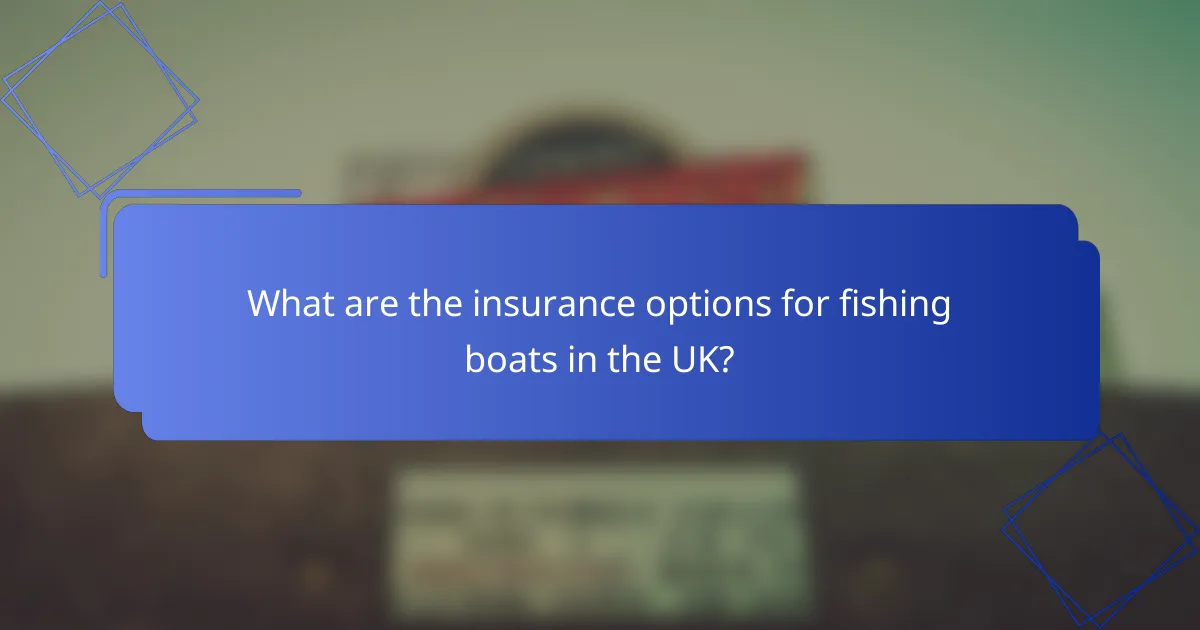
What are the insurance options for fishing boats in the UK?
In the UK, fishing boat insurance options typically include third-party liability, comprehensive coverage, and specific policies for commercial fishing. These options cater to different needs, from basic protection against damages to extensive coverage for equipment and loss of income.
Types of fishing boat insurance
The primary types of fishing boat insurance are third-party liability, which covers damages to other vessels or property, and comprehensive insurance, which protects against a wider range of risks including theft, damage, and loss of income. Some insurers also offer specialized policies for commercial fishing operations, which may include coverage for crew members and fishing gear.
Additionally, there are policies tailored for recreational fishing, which may have different coverage limits and exclusions compared to commercial policies. It’s essential to assess your specific needs to choose the right type of insurance.
Average insurance premiums
Insurance premiums for fishing boats in the UK can vary widely based on the type of coverage and the boat’s value. On average, boat owners might expect to pay anywhere from a few hundred to several thousand pounds annually. Comprehensive policies typically cost more than third-party liability due to the broader coverage they provide.
For example, a small recreational fishing boat might have premiums starting in the low hundreds, while larger commercial vessels could see premiums in the thousands. It’s advisable to obtain multiple quotes to find the best rate for your specific situation.
Factors influencing insurance costs
Several factors influence the cost of fishing boat insurance, including the boat’s age, size, and value, as well as the owner’s experience and claims history. Boats used for commercial purposes generally incur higher premiums due to increased risk and potential for higher claims.
Other considerations include the area where the boat is moored or operated, as certain locations may have higher theft or accident rates. Additionally, the type of fishing activities undertaken can affect premiums, with more hazardous activities typically leading to higher costs.

How to choose the right fishing boat insurance?
Selecting the right fishing boat insurance involves understanding your coverage needs, comparing providers, and recognizing potential exclusions. Prioritize policies that align with your specific fishing activities and the value of your boat.
Coverage options to consider
When evaluating fishing boat insurance, consider coverage options such as liability, hull insurance, and personal property coverage. Liability insurance protects against damages to others, while hull insurance covers physical damage to your boat.
Additionally, look for options like coverage for fishing gear and equipment, which can be essential if you carry expensive tackle or electronics. Some policies may also offer additional protections for towing and salvage operations.
Comparing insurance providers
To effectively compare insurance providers, gather quotes from multiple companies and assess their reputations. Look for reviews and ratings from other boat owners to gauge customer satisfaction and claims handling.
Pay attention to the policy limits and deductibles, as these can significantly impact your overall costs. A lower premium might come with higher deductibles, so evaluate what you can afford in the event of a claim.
Understanding policy exclusions
Every insurance policy has exclusions, which are specific conditions or circumstances that are not covered. Common exclusions in fishing boat insurance may include damage from racing, wear and tear, or operating under the influence of alcohol.
It’s crucial to read the fine print and ask questions about any exclusions that could affect your coverage. Understanding these limitations can help you avoid surprises when filing a claim.
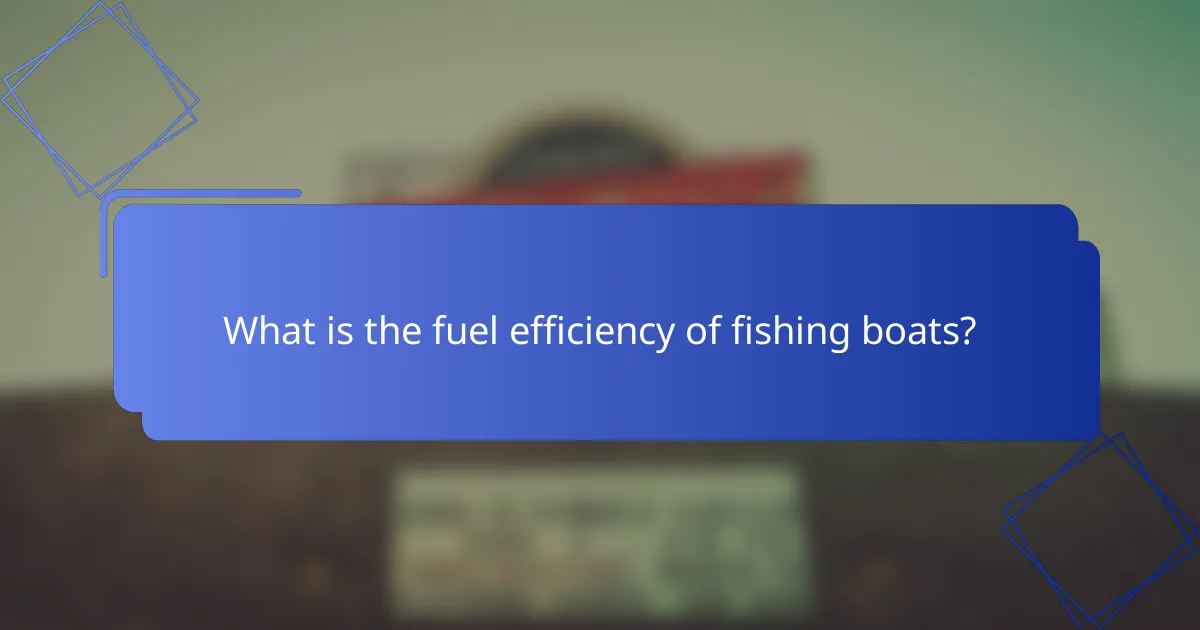
What is the fuel efficiency of fishing boats?
The fuel efficiency of fishing boats refers to how effectively they convert fuel into distance traveled or work done. This efficiency can vary widely based on the type of boat, its size, and operational practices.
Average fuel consumption rates
Fishing boats typically consume fuel at rates ranging from a few liters per hour to over 100 liters, depending on their size and engine type. Smaller boats may average around 5-15 liters per hour, while larger commercial vessels can exceed 50 liters per hour during operation. Understanding these rates is crucial for budgeting and operational planning.
Factors impacting fuel efficiency
Several factors influence the fuel efficiency of fishing boats, including hull design, weight, engine type, and operational speed. A well-designed hull can minimize drag, while lighter boats generally require less power to move. Additionally, engines that are properly maintained and optimized for the specific vessel can significantly enhance fuel efficiency.
Environmental conditions, such as water currents and wind, also play a role. Operating against strong currents or high winds can increase fuel consumption, while favorable conditions can improve efficiency.
Best practices for improving fuel efficiency
To enhance fuel efficiency, boat operators should consider regular maintenance of engines and hulls to ensure optimal performance. Keeping the hull clean and free from barnacles can reduce drag and improve fuel economy. Additionally, using fuel-efficient engines and propellers designed for specific boat types can lead to significant savings.
Adopting a steady cruising speed rather than frequent acceleration and deceleration can also help. Operators should avoid overloading the boat, as excess weight can lead to increased fuel consumption. Monitoring fuel usage and adjusting practices based on real-time data can further optimize efficiency.
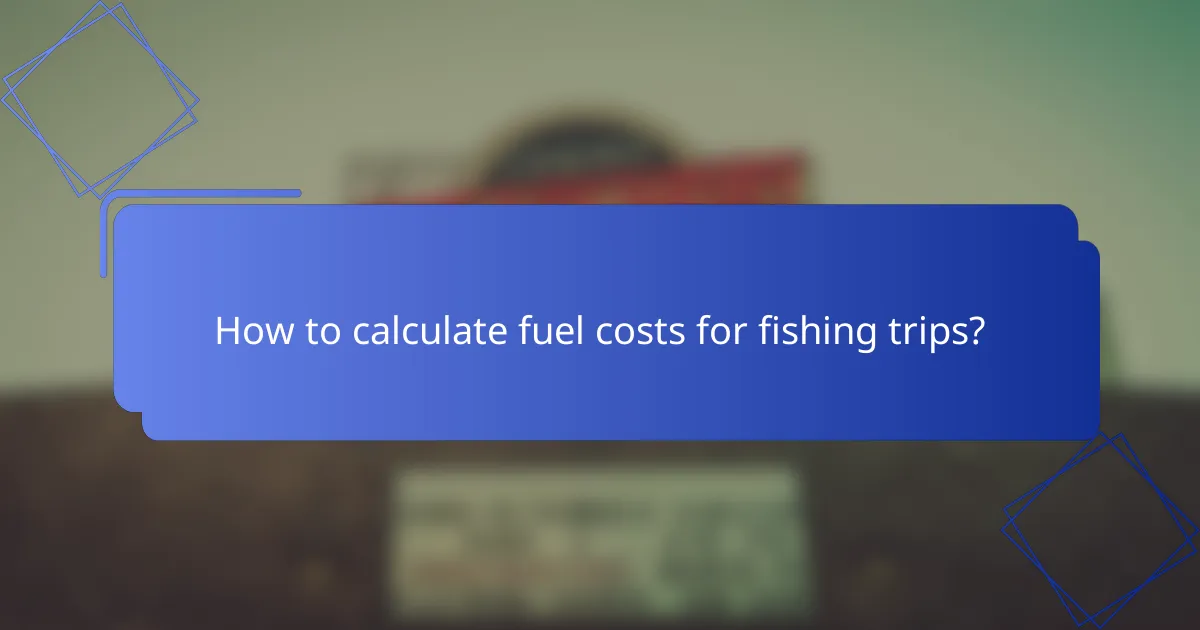
How to calculate fuel costs for fishing trips?
To calculate fuel costs for fishing trips, determine the distance you plan to travel, your boat’s fuel consumption rate, and the current fuel price. This will help you estimate the total fuel expenses for your trip.
Understanding fuel consumption rates
Fuel consumption rates vary based on the type of boat, engine size, and speed. Generally, fishing boats consume between 1 to 3 gallons per hour at cruising speed. Knowing your boat’s specific consumption rate is crucial for accurate cost estimates.
To find your boat’s fuel consumption, check the manufacturer’s specifications or perform a test run. Record the fuel used over a known distance to get a practical measure.
Calculating total distance
Total distance for your fishing trip includes both the journey to the fishing spot and the return trip. Measure the distance in nautical miles or kilometers, depending on your location. A common rule of thumb is to double the one-way distance for round trips.
For example, if your fishing destination is 10 nautical miles away, expect to travel a total of 20 nautical miles. This distance will directly impact your fuel cost calculations.
Estimating fuel costs
To estimate fuel costs, multiply your boat’s fuel consumption rate by the total distance and then by the current fuel price. For instance, if your boat consumes 2 gallons per hour, travels at 20 knots, and fuel costs $4 per gallon, you can expect to spend around $40 for a 2-hour trip.
Keep in mind that fuel prices can fluctuate, so check local prices before your trip. Additionally, consider potential delays or changes in your route that may affect fuel usage.
